
Lomatium macrocarpum is a perennial flowering plant in the carrot family known by the common names bigseed lomatium, biscuit root or bigseed biscuitroot. It is native to much of western North America, where it can be found in various types of habitat, including the grasslands of the Great Plains. It is spreading or erect perennial herb growing up to about half a meter long with hairy, gray-green herbage. The leaves are up to about 24 centimeters long and are intricately divided into many small, narrow segments. The inflorescence bears an umbel of yellowish, purplish, or white flowers. The fruit is a compressed, winged, round or oval disc up to about 2 centimeters long.
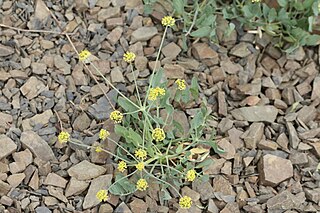
Lomatium nudicaule is a species of flowering plant in the carrot family known by the common names pestle lomatium, barestem biscuitroot, Indian celery and Indian consumption plant. It is native to western North America from British Columbia to California to Utah, where it is known from several habitat types, including forest and woodland. It is a perennial herb growing up to about 70 centimeters tall from a thick taproot. It generally lacks a stem, the inflorescence and leaves emerging from ground level. The leaves are made up of many dull green, waxy lance-shaped leaflets each up to 9 centimeters long. The inflorescence is borne on a stout peduncle widening at the top where it blooms in an umbel of yellow or purplish flowers.

Lomatium utriculatum is a species of flowering plant in the carrot family known by the common name common lomatium or spring gold. It is native to western North America from British Columbia to California, where it grows in many types of habitat including chaparral, and in the Sierra Nevada.

Lomatium canbyi is a species of flowering plant in the carrot family known by the common name Canby's biscuitroot. It is native to the Pacific Northwest of the United States and northeast California, where it grows in sagebrush-covered plateau habitat and barren flats.
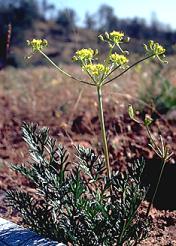
Lomatium congdonii, known by the common names Mariposa desertparsley and Congdon's lomatium, is a species of flowering plant in the carrot family.

Lomatium caruifolium, known by the common name alkali desertparsley, is a species of flowering plant in the carrot family.
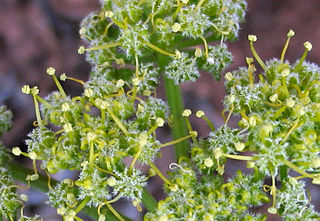
Lomatium dasycarpum is a species of flowering plant in the carrot family known by the common name woollyfruit desertparsley. It is native to California and Baja California, where it is widespread throughout many of the mountain ranges, including the Peninsular, Sierra Nevada, and California Coast Ranges, and in valleys.
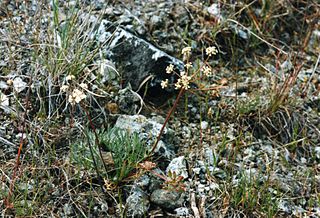
Lomatium engelmannii is an uncommon species of flowering plant in the carrot family known by the common name Engelmann's desertparsley, or Engelmann's lomatium. It is native to the Klamath Mountains of southern Oregon and northern California, where it is a member of the local serpentine soils flora.

Lomatium howellii is an uncommon species of flowering plant in the carrot family known by the common name Howell's biscuitroot, or Howell's lomatium. It is native to the Klamath Mountains of southern Oregon and northern California, where it is a member of the local serpentine soils flora.
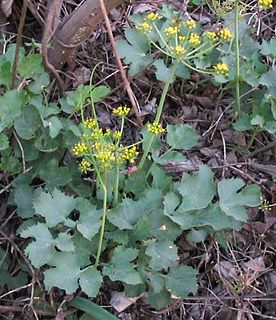
Lomatium lucidum is a species of flowering plant in the carrot family known by the common name shiny biscuitroot. It is native to coastal mountains and canyons of southern California and Baja California, where it is a member of the chaparral plant community, including recently burned areas. It is found in the eastern Transverse Ranges and the South Coast region.

Lomatium martindalei is a species of flowering plant in the carrot family known by the common names Cascade desertparsley and coast range lomatium. It is native to the west coast of North America, from Vancouver Island south to the Klamath Mountains of far northern California. It can be found in a number of coastal and inland habitats, from coastal plains to high mountain talus and meadows. This is a perennial herb growing 15 to 40 centimeters tall from a carrot-like taproot. There is often no stem, the erect or spreading leaves and inflorescence emerging from ground level. The thinly fleshy leaves may approach 20 centimeters long, their blades divided into leaflets made up of many small oval segments. The inflorescence bears an umbel of small yellowish flowers.

Lomatium mohavense is a species of flowering plant in the carrot family known by the common name Mojave desertparsley. It is native to southern California with a few outlying populations in Arizona, Nevada and Baja California. It is found in several types of mountain and desert habitat, including chaparral, woodland, and scrub, mostly from 2,000–7,000 feet (600–2,100 m) elevation.

Lomatium nevadense is a species of flowering plant in the carrot family known by the common name Nevada biscuitroot. It is native to the western United States and northern Mexico, where it is known from several different habitat types, including sagebrush and woodlands. It is a perennial herb growing up to about 45 centimeters tall from a taproot. The leaves are up to about 16 centimeters long, their blades divided into many oblong pointed segments. The inflorescence is an umbel of white or cream flowers.
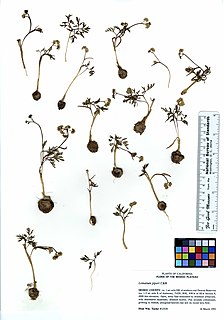
Lomatium piperi is a species of flowering plant in the carrot family known by the common name salt-and-pepper or Indian biscuitroot. It is native to the Northwestern United States and northern California, where it grows in sagebrush and plateau habitat, and the Sierra Nevada and Cascade Mountains.
Lomatium shevockii is a rare species of flowering plant in the carrot family known by the common name Owens Peak desertparsley, or Owens Peak lomatium. It is endemic to Kern County, California, where it is known from only two occurrences at Owens Peak, one of the highest points of the Sierra Nevada. It is a plant of the talus and wooded slopes of the high mountains. This species was discovered in 1984 and first described to science in 1988.

Lomatium stebbinsii, known by the common name Stebbins' desertparsley, is a rare species of flowering plant in the carrot family.

Lomatium torreyi is a species of flowering plant in the carrot family known by the common name Sierra biscuitroot. It is endemic to the Sierra Nevada of California, where it grows in the forests of the high mountains.

Lomatium tracyi is a species of flowering plant in the carrot family known by the common name Tracy's desertparsley, or Tracy's lomatium. It is native to the mountains of northern California and southern Oregon, where it grows in the forests on the slopes, often on serpentine soils. It is a perennial herb growing up to 35 centimeters tall from a slender taproot. There is generally no stem, the leaves and inflorescence emerging at ground level. The leaf blades are divided and subdivided into a mass of overlapping threadlike to oval segments. The inflorescence is an umbel of yellow flowers.

Lomatium triternatum is a species of flowering plant in the carrot family known by the common name nineleaf biscuitroot. It is native to western North America from British Columbia to California to Colorado, where it grows in many types of habitat. It is a hairy perennial herb growing up to a meter tall from a taproot. The leaves emerge from the lower part of the stem. Each is generally divided into three leaflets which are each subdivided into three linear leaflike segments. The inflorescence is an umbel of yellow flowers, each cluster on a ray up to 10 centimeters long.

Lomatium observatorium is a rare species of flowering plant in the carrot family known by the common names Mt. Hamilton desertparsley and Mount Hamilton lomatium. It is endemic to California, where it is known only from the mountains of Santa Clara County, including Mount Hamilton near the Lick Observatory. It may also occur in Stanislaus County. Its habitat includes mountain woodlands on volcanic and metamorphosed sedimentary rock substrates. Described The plant to science as a new species in 1996, the plant is a perennial herb growing low to the ground, the lightly hairy herbage growing from a long taproot.


















